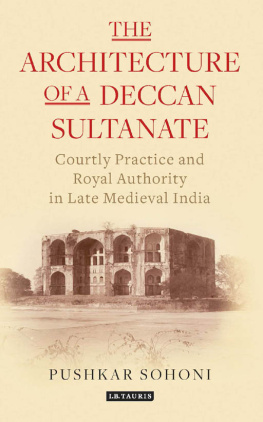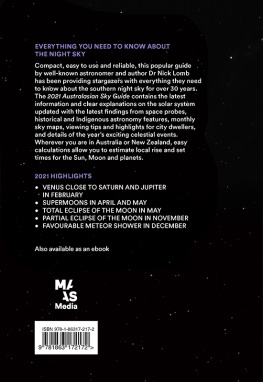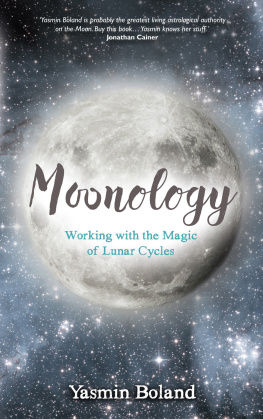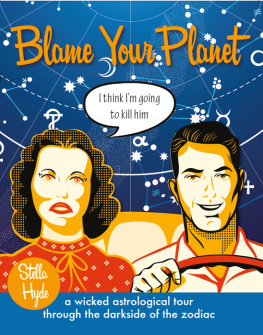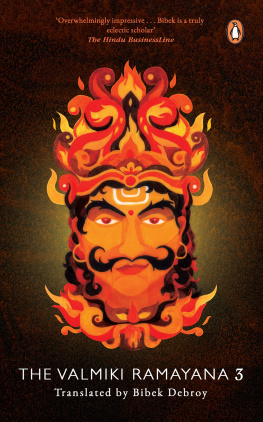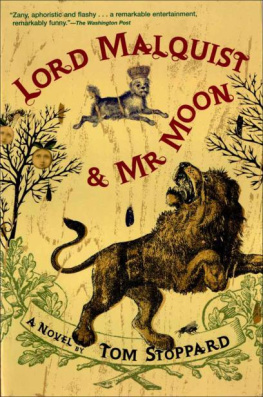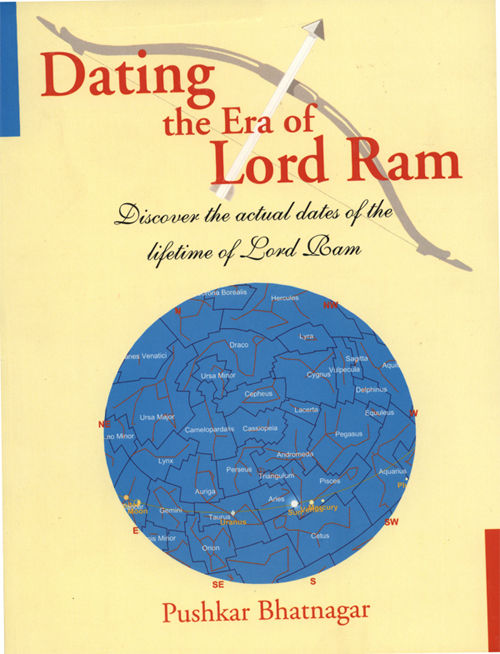
DATING THE ERA OF
LORD RAM
DATING THE ERA OF
LORD RAM
Pushkar Bhatnagar
Copyright Pushkar Bhatnagar 2004
First Published 2004
Third Impression 2011
Published by
Rupa Publications India Pvt. Ltd.
7/16, Ansari Road, Daryaganj,
New Delhi 110 002
Sales Centres:
Allahabad Bengaluru Chennai
Hyderabad Jaipur Kathmandu
Kolkata Mumbai
All rights reserved.
No part of this publication may be reproduced, stored in a retrieval system, or transmitted, in any form or by any means, electronic, mechanical, photocopying, recording or otherwise, without the prior permission of the publishers.
The author asserts the moral right to be identified as the author of this work.
Designed & typeset by
Arrt Creations
45 Nehru Apts. Kalkaji
New Delhi 110 019
Printed in India by
Gopsons Papers Ltd.
A-14 Sector 60
Noida 201 301
CONTENTS
CHAPTER I
CHAPTER II
CHAPTER III
CHAPTER IV
CHAPTER V
CHAPTER VI
CHAPTER VII
CHAPTER VIII
CHAPTER IX
CHAPTER X
CHAPTER XI
CHAPTER XII
CHAPTER XIII
CHAPTER XIV
Preface
I REMEMBER THE month of October 1991 when I was diagnosed with kidney cancer. Within a week, my ailing right kidney was removed under a major surgery. Contrary to normal expectations, that was just the beginning of the agony. Nobody could promise even five years of life to me. Doctors wrote me off on the basis of the biopsy report, which showed that I suffered from a very fast spreading tumor. In those painful and excruciating times, I took refuge at the benign feet of Lord Ram.
Ever since my childhood, I had a lot of interest in the life of Lord Ram. I used to read the Ramcharitmanas with great devotion and rapt attention. The more I read, the more my curiosity grew about Lord Ram's actual life. The turmoil of 1991 in my life brought me closer to him. Time passed at its own slow pace. In 1993, one of my colleagues presented me with a copy of a Hindi translation of the Ramayana written by Sage Valmiki. I would, perhaps, never be able to thank that friend enough for that invaluable gift.
Repeated readings of the Ramayana led to the creation of a highly realistic picture of Lord Ram in my mind. The reason was that the book provides the minutest of details about his personality, physique, conversations, surroundings etc. At the same time, another passion of my life - understanding more about astronomy, got a big impetus because of the advent of Internet in India. I kept browsing the web to learn more and more about the celestial phenomenon. Soon I downloaded a number of software that were capable of displaying the positions of planets and stars on the monitor of my PC at the time of making the observation.
A broader knowledge of astronomy and finer readings of the Ramayana soon made me notice that the text of the book is replete with a number of astronomical references, which were comprehensive enough to suggest the exact date when they were actually seen in the sky. I started searching the software that was capable of generating the sky view on the computer monitor for any given point of time in histoiy. My hunt ended with the purchase of the Planetarium Gold software.
By the year 1999,1 had arrived at the date of the birth of Lord Ram and I was thrilled to find that every detail of the planetary configuration given by Valmiki in this regard tallied with the view of the sky generated for that date by the software. The puzzle of finding the nakshatra of King Dashrath took another six months and at least one fresh reading of the Ramayana. The confirmation of the occurrence of the solar eclipse described in the Ramayana to mark the battle between Lord Ram and Khar made me ecstatic. It proved, independently, the accuracy of the findings. Despite being certain that I had discovered the precise dates for the actual lifetime of Lord Ram, I refrained from writing any book on the findings as the motive behind this investigation was contentment and self-satisfaction rather than publicity or business. However, after about three years, the interest generated by a few articles on this subject in some newspapers, persuaded me to get the matter published with a view to share my findings with all those who are interested in it.
Every finding discussed in the book has been arrived at after putting in a lot of effort and spending considerable time On a number of occasions, I remained stuck for long periods and the solution was nowhere in sight. However, every time intuition, sixth sense or as I believe, divine help, prompted the answer in my mind. I would like to describe one such instance in some detail.
The Ramayana clearly mentions that a lunar eclipse had occurred on the day Hanuman visited Lanka in search of Sita. On examination of the sequence of events narrated in the book, I had concluded that it was the full moon day of either the month of Margshirsh or Paush of the last year of exile (5076 BC). However, I had no means to verify whether a lunar eclipse had actually occurred about 7,000 years or not. My belief and understanding was that the software I was using did not have the capability of showing the occurrence of a lunar eclipse. I browsed the web for any other software, searched the data banks and even enquired from some experts whether there was any algebric equation or mathematical formula by which the occurrence of a lunar eclipse, about 7,000 years ago, could be ascertained. These efforts bore no fruit. For almost five years I had desperately wished and prayed that somehow I could verify and demonstrate the occurrence of a lunar eclipse so that my findings become complete in all respects.
Since no solution could be found to this puzzle and being completely helpless in this regard, I submitted the manuscript to my publishers for publication in the month of October 2003. It contained a paragraph mentioning that though it was clear that a lunar eclipse took place on the evening when Hanuman visited Lanka and met Sita, there were no means available to prove or demonstrate that such an eclipse had actually occurred. I also mentioned that as per the sequence of events, the lunar eclipse should have occurred on the full moon day of either the lunar month of Margshirsh or Paush of that year.
After a few days, I read in the newspapers that a lunar eclipse was to occur on the morning of 9 November 2003 and it would be visible from India. Late in the evening of the 8th , without any specific hope of finding a solution, intuitively I felt like examining the position of the sun and the moon during the eclipse due to occur the next day, through the software. My intention was to compare the positions of the sun and the moon during the eclipse on 9 November 2003, with those on the probable dates on which I believed that the lunar eclipse had occurred when Hanuman visited Sita. I thought of reaching a conclusion directly or indirectly in this manner.
However, as soon as I entered the time of the occurrence of the lunar eclipse on 9 November 2003 in the software (since it was known through the newspaper), I was surprised to find that the software was displaying the occurrence of the lunar eclipse very precisely. Without wasting a moment, I entered the date 12 September 5076 BC, (full-moon day of lunar month of Margshirsh), which according to me, was the day Hanuman visited Lanka and the day on which a lunar eclipse must have occurred. With a pounding heart, I started examining the position of the Moon. And then came the stamp of divine confirmation! The software demonstrated that a lunar eclipse had indeed occurred that evening - exactly at the time when it has been described in the Ramayana. I could not believe that a five-year-long hopelessness was transformed into triumph in just a matter of five minutes. Filled with a sense of blissful delight and gratitude, I bowed before the picture of Lord Ram. This issue had been a quagmire to me for years. Resigned to the fate, I had submitted the manuscript fully aware of this deficiency. If the lunar eclipse had not occurred on 9 November and if someone had not prompted me to examine the position of the sun and the moon on that day, the study would have contained a grave ambiguity forever. This, I believe, is the difference between "our efforts" of five years and "God's wish" of five minutes. Needless to mention, I revised the manuscript by adding a fresh chapter and resubmitted it for publication.
Next page


